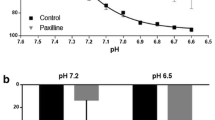Abstract
The membrane potential of the endothelial cells on a strip of pig coronary artery was recorded. The fluorescent dye lucifer yellow was injected into the recorded cell in order to prove its identity. We show that substance P transiently hyperpolarized these cells. The function of the endothelial cell hyperpolarization could be important for the role played by the endothelium and the kinins in inflammation.
Similar content being viewed by others
References
F. Lembeck,The 1988 Ulf von Euler Lecture. Acta Physiol. Scand.133, 435–454 (1988).
A. Loesch and G. Burnstock,Ultrastructural localisation of serotonin and substance P in vascular endothelial cells of rat femoral and mesenteric arteries. Anat. Embryol.178, 137–142 (1988).
N. Gulati, R. Mathison, H. Huggel, D. Regoli and J.-L. Bény,Effects of neurokinins on the isolated pig coronary artery, Eur. J. Phrmacol.137, 149–154 (1987).
J.-L. Bény, P. C. Brunet and H. Huggel,Effect of mechanical stimulation, substance P and vasoactive intestinal polypeptide on the electrical and mechanical activities of circular smooth muscles from pig coronary arteries contracted with acetylcholine: role of endothelium. Pharmacology33, 61–68 (1986).
P. C. Brunet and J.-L. Bény,Substance P and bradykinin hyperpolarize pig coronary artery cells in primary culture. Blood Vessels488, 228–234 (1989).
B. J. Northover,The membrane potential of vascular endothelial cells. Adv. Microcirc.9, 135–160 (1980).
J.-L. Bény and F. Gribi,Dye and electrical coupling of endothelial cells in situ. Tissue and Cell21, 797–802 (1989).
J.-L. Bény,Endothelial and smooth muscle cells hyperpolarized by bradykinin are not dye coupled. Am. J. Physiol.258, 836–841 (1990).
K. G. Smithson, B. A. MacVicar and G. I. Hatton,Polyethylene glycol embedding: a technique compatible with immunocytochemistry, enzyme histochemistry, histofluorescence and intracellular staining. J. Neurosci. Methods7, 27–41 (1983).
R. Busse, H. Fichtner, A. Lückhoff and M. Kohlardt,Hyperpolarization and increased free calcium in acetylcholine-stimulated endothelial cells. Am. J. Physiol.255, H965-H969 (1988).
P. Bregestovski, A. Bakhramov, S. Danilov, A. Moldobaeva and K. Takeda,Histamine-induced inward currents in cultured endothelial cells from human umbilical vein. Br. J. Pharmacol.95, 429–436 (1988).
S. S. Segal, D. N. Damon and B. R. Duling,Propagation of vasomotor responses coordinates arteriolar resistances. Am. J. Physiol.256, H832-H837 (1989).
W. P. Schiling,Effect of membrane potential on cytosolic calcium of bovine aortic endothelial cells. Am. J. Physiol.257, H778-H784 (1989).
Author information
Authors and Affiliations
Rights and permissions
About this article
Cite this article
Bény, J.L. Effect of substance P on the membrane potential of coronary arterial endothelial cellsin situ . Agents and Actions 31, 317–320 (1990). https://doi.org/10.1007/BF01997626
Received:
Accepted:
Issue Date:
DOI: https://doi.org/10.1007/BF01997626




